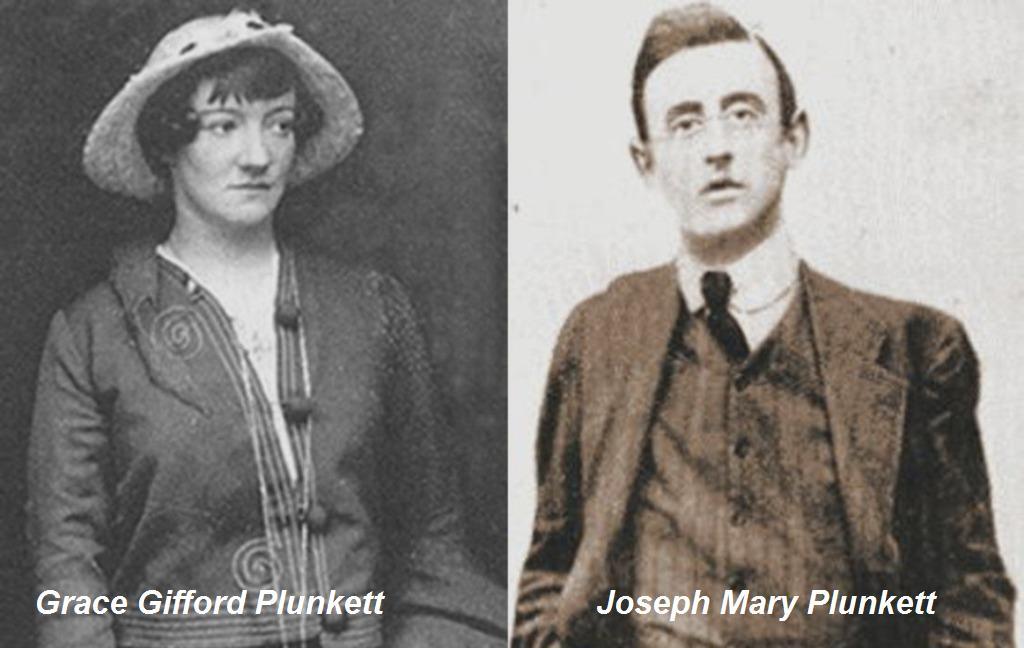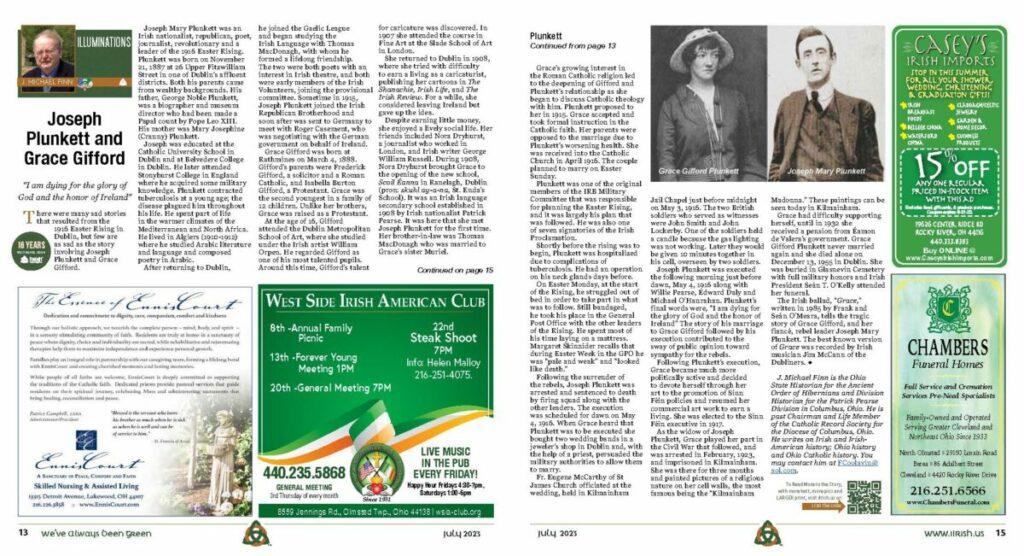

By J. Michael Finn

There were many sad stories that resulted from the 1916 Easter Rising in Dublin, but few are as sad as the story involving Joseph Plunkett and Grace Gifford.
Joseph Mary Plunkett was an Irish nationalist, republican, poet, journalist, revolutionary and a leader of the 1916 Easter Rising. Plunkett was born on November 21, 1887 at 26 Upper Fitzwilliam Street in one of Dublin’s affluent districts. Both his parents came from wealthy backgrounds. His father, George Noble Plunkett, was a biographer and museum director who had been made a Papal count by Pope Leo XIII. His mother was Mary Josephine (Cranny) Plunkett.
Joseph was educated at the Catholic University School in Dublin and at Belvedere College in Dublin. He later attended Stonyhurst College in England where he acquired some military knowledge. Plunkett contracted tuberculosis at a young age; the disease plagued him throughout his life. He spent part of life in the warmer climates of the Mediterranean and North Africa. He lived in Algiers (1910-1912) where he studied Arabic literature and language and composed poetry in Arabic.
After returning to Dublin, he joined the Gaelic League and began studying the Irish Language with Thomas MacDonagh, with whom he formed a lifelong friendship. The two were both poets with an interest in Irish theatre, and both were early members of the Irish Volunteers, joining the provisional committee. Sometime in 1915, Joseph Plunkett joined the Irish Republican Brotherhood and soon after was sent to Germany to meet with Roger Casement, who was negotiating with the German government on behalf of Ireland.
Grace Gifford was born at Rathmines on March 4, 1888. Gifford’s parents were Frederick Gifford, a solicitor and a Roman Catholic, and Isabella Burton Gifford, a Protestant. Grace was the second youngest in a family of 12 children. Unlike her brothers, Grace was raised as a Protestant.
At the age of 16, Gifford attended the Dublin Metropolitan School of Art, where she studied under the Irish artist William Orpen. He regarded Gifford as one of his most talented pupils. Around this time, Gifford’s talent for caricature was discovered. In 1907 she attended the course in Fine Art at the Slade School of Art in London.
She returned to Dublin in 1908, where she tried with difficulty to earn a living as a caricaturist, publishing her cartoons in The Shanachie, Irish Life, and The Irish Review. For a while, she considered leaving Ireland but gave up the idea.
Despite earning little money, she enjoyed a lively social life. Her friends included Nora Dryhurst, a journalist who worked in London, and Irish writer George William Russell. During 1908, Nora Dryhurst brought Grace to the opening of the new school, Scoil Éanna in Ranelagh, Dublin (pron: skuhl ay-a-na, St. Enda’s School). It was an Irish language secondary school established in 1908 by Irish nationalist Patrick Pearse. It was here that she met Joseph Plunkett for the first time. Her brother-in-law was Thomas MacDonagh who was married to Grace’s sister Muriel.
Grace’s growing interest in the Roman Catholic religion led to the deepening of Gifford and Plunkett’s relationship as she began to discuss Catholic theology with him. Plunkett proposed to her in 1915. Grace accepted and took formal instruction in the Catholic faith. Her parents were opposed to the marriage due to Plunkett’s worsening health. She was received into the Catholic Church in April 1916. The couple planned to marry on Easter Sunday.
Plunkett was one of the original members of the IRB Military Committee that was responsible for planning the Easter Rising, and it was largely his plan that was followed. He was also one of seven signatories of the Irish Proclamation.
Shortly before the rising was to begin, Plunkett was hospitalized due to complications of tuberculosis. He had an operation on his neck glands days before.
On Easter Monday, at the start of the Rising, he struggled out of bed in order to take part in what was to follow. Still bandaged, he took his place in the General Post Office with the other leaders of the Rising. He spent most of his time laying on a mattress. Margaret Skinnider recalls that during Easter Week in the GPO he was “pale and weak” and “looked like death.”
Following the surrender of the rebels, Joseph Plunkett was arrested and sentenced to death by firing squad along with the other leaders. The execution was scheduled for dawn on May 4, 1916. When Grace heard that Plunkett was to be executed she bought two wedding bands in a jeweler’s shop in Dublin and, with the help of a priest, persuaded the military authorities to allow them to marry.
Fr. Eugene McCarthy of St James Church officiated at the wedding, held in Kilmainham Jail Chapel just before midnight on May 3, 1916. The two British soldiers who served as witnesses were John Smith and John Lockerby. One of the soldiers held a candle because the gas lighting was not working. Later they would be given 10 minutes together in his cell, overseen by two soldiers.
Joseph Plunkett was executed the following morning just before dawn, May 4, 1916 along with Willie Pearse, Edward Daly and Michael O’Hanrahan. Plunkett’s final words were, “I am dying for the glory of God and the honor of Ireland” The story of his marriage to Grace Gifford followed by his execution contributed to the sway of public opinion toward sympathy for the rebels.
Following Plunkett’s execution, Grace became much more politically active and decided to devote herself through her art to the promotion of Sinn Féin policies and resumed her commercial art work to earn a living. She was elected to the Sinn Féin executive in 1917.
As the widow of Joseph Plunkett, Grace played her part in the Civil War that followed, and was arrested in February, 1923, and imprisoned in Kilmainham. She was there for three months and painted pictures of a religious nature on her cell walls, the most famous being the “Kilmainham Madonna.” These paintings can be seen today in Kilmainham.
Grace had difficulty supporting herself, until in 1932 she received a pension from Éamon de Valera’s government. Grace Gifford Plunkett never married again and she died alone on December 13, 1955 in Dublin. She was buried in Glasnevin Cemetery with full military honors and Irish President Seán T. O’Kelly attended her funeral.
The Irish ballad, “Grace,” written in 1985 by Frank and Seán O’Meara, tells the tragic story of Grace Gifford, and her fiancé, rebel leader Joseph Mary Plunkett. The best known version of Grace was recorded by Irish musician Jim McCann of the Dubliners.


*J. Michael Finn is the Ohio State Historian for the Ancient Order of Hibernians and Division Historian for the Patrick Pearse Division in Columbus, Ohio. He is also past Chairman and Life Member of the Catholic Record Society for the Diocese of Columbus, Ohio. He writes on Irish and Irish-American history; Ohio history and Ohio Catholic history. You may contact him at [email protected].


Monthly newsmagazine serving people of Irish descent from Cleveland to Clearwater. We cover the movers, shakers & music makers each and every month.
Since our 2006 inception, iIrish has donated more than $376,000 to local and national charities.
GET UPDATES ON THE SERIOUS & THE SHENANIGANS!